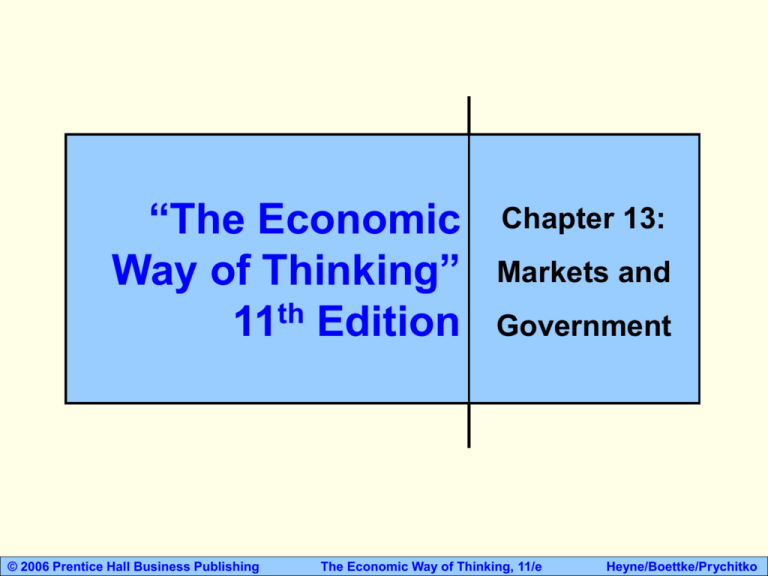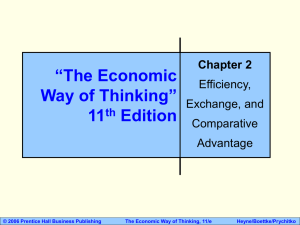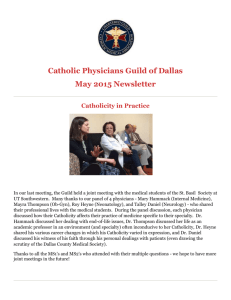CHAPTER 1
advertisement

“The Economic Way of Thinking” 11th Edition © 2006 Prentice Hall Business Publishing Chapter 13: Markets and Government The Economic Way of Thinking, 11/e Heyne/Boettke/Prychitko Chapter 13 Outline • Introduction • Private Versus Public? • Competition and Individualism • Economic Theory and Government Action • The Right to Use Coercion • Is Government Necessary? © 2006 Prentice Hall Business Publishing The Economic Way of Thinking, 11/e Heyne/Boettke/Prychitko 2 of 45 Chapter 13 Outline • Excluding Nonpayers • The Free-Ride Problem • Positive Externalities and Free-Riders • Law and Order • National Defense • Roads and Schools © 2006 Prentice Hall Business Publishing The Economic Way of Thinking, 11/e Heyne/Boettke/Prychitko 3 of 45 Chapter 13 Outline • Income Redistribution • The Regulation of Voluntary Exchange • Government and the Public Interest • Information and Democratic Governments • The Interests of Elected Officials • Concentrated Benefits, Dispersed Costs © 2006 Prentice Hall Business Publishing The Economic Way of Thinking, 11/e Heyne/Boettke/Prychitko 4 of 45 Chapter 13 Outline • Positive Externalities and Government Policies • How Do People Identify the Public Interest? • The Prisoner’s Dilemma • The Limits of Political Institutions © 2006 Prentice Hall Business Publishing The Economic Way of Thinking, 11/e Heyne/Boettke/Prychitko 5 of 45 Introduction • Key questions in constitutional political economy – What should be left to the market? – What are the appropriate tasks for government? © 2006 Prentice Hall Business Publishing The Economic Way of Thinking, 11/e Heyne/Boettke/Prychitko 6 of 45 Private Versus Public? • The market usually characterizes the private sector. • Government agencies and officials comprise the public sector. • Question – Does individual self-interest play a role in the public sector? © 2006 Prentice Hall Business Publishing The Economic Way of Thinking, 11/e Heyne/Boettke/Prychitko 7 of 45 Competition and Individualism • The market sector is often referred to as the competitive sector. • Question – Is there competition in the government? • Competition in the public sector – Elections – Government agencies – Passing legislation © 2006 Prentice Hall Business Publishing The Economic Way of Thinking, 11/e Heyne/Boettke/Prychitko 8 of 45 Economic Theory and Government Action • Economic Theory – All participants are concerned with self-interest and behave rationally. – If the marginal revenue of an activity exceeds the marginal cost, the activity should be expanded. – If the marginal cost of an activity exceeds the marginal revenue, the activity should be contracted. © 2006 Prentice Hall Business Publishing The Economic Way of Thinking, 11/e Heyne/Boettke/Prychitko 9 of 45 Economic Theory and Government Action • Question – Does the government make decisions in the same way? © 2006 Prentice Hall Business Publishing The Economic Way of Thinking, 11/e Heyne/Boettke/Prychitko 10 of 45 Economic Theory and Government Action • Governments: – – – – Have limited resources. Wants exceed the capacity of the resources. Must allocate their resources. Will use incentives to determine the optimal allocation. © 2006 Prentice Hall Business Publishing The Economic Way of Thinking, 11/e Heyne/Boettke/Prychitko 11 of 45 Economic Theory and Government Action • What is the role of property rights in government behavior? © 2006 Prentice Hall Business Publishing The Economic Way of Thinking, 11/e Heyne/Boettke/Prychitko 12 of 45 The Right to Use Coercion • Government possesses a generally conceded and exclusive right to coerce adults. © 2006 Prentice Hall Business Publishing The Economic Way of Thinking, 11/e Heyne/Boettke/Prychitko 13 of 45 The Right to Use Coercion • Coercion – To induce cooperation by threatening to reduce people’s options. • Persuasion – To induce cooperation by promising to expand people’s options. © 2006 Prentice Hall Business Publishing The Economic Way of Thinking, 11/e Heyne/Boettke/Prychitko 14 of 45 The Right to Use Coercion • Examples of Coercion – Traffic laws – Easements – Code enforcement © 2006 Prentice Hall Business Publishing The Economic Way of Thinking, 11/e Heyne/Boettke/Prychitko 15 of 45 The Right to Use Coercion • We may be able to achieve greater freedom and expanded options if we all accept some limitations of our freedom and some reduction in our options. © 2006 Prentice Hall Business Publishing The Economic Way of Thinking, 11/e Heyne/Boettke/Prychitko 16 of 45 Is Government Necessary? • How much police protection did you consume last month? • Would police protection be available without government? © 2006 Prentice Hall Business Publishing The Economic Way of Thinking, 11/e Heyne/Boettke/Prychitko 17 of 45 Excluding Nonpayers • Without government – People who wanted police and/or fire protection could pay for it. – Could their neighbors be excluded? – How does this impact a person’s willingness to pay for protection? © 2006 Prentice Hall Business Publishing The Economic Way of Thinking, 11/e Heyne/Boettke/Prychitko 18 of 45 Excluding Nonpayers • Positive Externalities and Free-Riders – Spillover benefits reduce the incentive to produce certain goods. • Positive Externalities and Free-Riders – Government can create an incentive to produce goods through coercion which reduces the transaction cost. © 2006 Prentice Hall Business Publishing The Economic Way of Thinking, 11/e Heyne/Boettke/Prychitko 19 of 45 The Free-Rider Problem • Free-Riders – People who accept benefits without paying their share of the cost of providing those benefits. • Question – Why don’t people do what would clearly make themselves and others better off? © 2006 Prentice Hall Business Publishing The Economic Way of Thinking, 11/e Heyne/Boettke/Prychitko 20 of 45 The Free-Rider Problem People are guided by the costs they expect to bear and benefits they expect to receive. © 2006 Prentice Hall Business Publishing The Economic Way of Thinking, 11/e Heyne/Boettke/Prychitko 21 of 45 Positive Externalities and Free-Riders • Positive Externalities – Exist alongside negative externalities. – Create a disincentive to produce. – Probably more prevalent than spillover costs. © 2006 Prentice Hall Business Publishing The Economic Way of Thinking, 11/e Heyne/Boettke/Prychitko 22 of 45 Positive Externalities and Free-Riders • Exchange entails transaction costs. • Transaction Costs – Reduce exchanges if they exceed marginal benefits. • Government Coercion – Reduces transaction costs. © 2006 Prentice Hall Business Publishing The Economic Way of Thinking, 11/e Heyne/Boettke/Prychitko 23 of 45 Law and Order • High transaction costs make it difficult to exclude free-riders. • Government coercion forces everyone to pay involuntary contributions (taxes). © 2006 Prentice Hall Business Publishing The Economic Way of Thinking, 11/e Heyne/Boettke/Prychitko 24 of 45 Law and Order • Uniform and Consistent Rules – Increase planning confidence – Contribute to cooperating society • Examples – Defining property rights – Enforcement of contracts © 2006 Prentice Hall Business Publishing The Economic Way of Thinking, 11/e Heyne/Boettke/Prychitko 25 of 45 National Defense • National Defense – A public good – A traditional role of government – Can’t be provided privately due to the free-rider problem. – Does not have to be solely provided through coercion. © 2006 Prentice Hall Business Publishing The Economic Way of Thinking, 11/e Heyne/Boettke/Prychitko 26 of 45 Roads and Schools • Question – Would the quantity and quality of roads be the same if coercion was not used to finance them? © 2006 Prentice Hall Business Publishing The Economic Way of Thinking, 11/e Heyne/Boettke/Prychitko 27 of 45 Roads and Schools • Transaction Costs – Would be high if tolls were relied on to finance roads. • Question – Do others benefit from road development? © 2006 Prentice Hall Business Publishing The Economic Way of Thinking, 11/e Heyne/Boettke/Prychitko 28 of 45 Roads and Schools • Education – People acquire education only as long as the marginal benefit exceeds the marginal cost. – Positive externalities result. • Education – Less than optimal will be obtained when external benefits are not considered. – Taxes to finance education lowers the cost and increases the demand. © 2006 Prentice Hall Business Publishing The Economic Way of Thinking, 11/e Heyne/Boettke/Prychitko 29 of 45 Income Redistribution • The government provides special benefits to the impoverished. • Question – Why not rely on private philanthropy? • Hint: Free-riders © 2006 Prentice Hall Business Publishing The Economic Way of Thinking, 11/e Heyne/Boettke/Prychitko 30 of 45 The Regulation of Voluntary Exchange • Reducing Transaction Costs – Licensing – Certification – Setting standards © 2006 Prentice Hall Business Publishing The Economic Way of Thinking, 11/e Heyne/Boettke/Prychitko 31 of 45 Government and the Public Interest • Government attempts to address sources of market failure. – Transaction costs – Positive externalities – Free-riders • Question – How would the lack of perfect information and incentives impact the government’s ability to act in the public interest? © 2006 Prentice Hall Business Publishing The Economic Way of Thinking, 11/e Heyne/Boettke/Prychitko 32 of 45 Government and the Public Interest • Why are government policies dominated by special interests? • Why are governments more likely to oversupply than undersupply a public good? © 2006 Prentice Hall Business Publishing The Economic Way of Thinking, 11/e Heyne/Boettke/Prychitko 33 of 45 Information and Democratic Governments • Question – Why don’t you take the time to learn more about the candidates running for various offices? • Question – Is an interest in being re-elected likely to lead elected officials to vote and act in the public interest? © 2006 Prentice Hall Business Publishing The Economic Way of Thinking, 11/e Heyne/Boettke/Prychitko 34 of 45 The Interests of Elected Officials • Observation – The few who have much to gain invest vast resources in trying to influence the political process. • Observation – The many with more to gain in total, but less to gain individually, invest almost nothing. © 2006 Prentice Hall Business Publishing The Economic Way of Thinking, 11/e Heyne/Boettke/Prychitko 35 of 45 Concentrated Benefits, Dispersed Costs • Democratic political process – Concentrate benefits on the • Well organized • Well informed • Who gain the most – Disperse costs on • Unorganized • Ill-informed • With little to gain individually © 2006 Prentice Hall Business Publishing The Economic Way of Thinking, 11/e Heyne/Boettke/Prychitko 36 of 45 Positive Externalities and Government Policies • Government policies – tend to be dominated by special interests. © 2006 Prentice Hall Business Publishing The Economic Way of Thinking, 11/e Heyne/Boettke/Prychitko 37 of 45 How Do People Identify the Public Interest? • Scenario – How long should a new drug be tested by the FDA? © 2006 Prentice Hall Business Publishing The Economic Way of Thinking, 11/e Heyne/Boettke/Prychitko 38 of 45 How Do People Identify the Public Interest? Costs and Benefits Benefits to patients of additional testing Costs to patients of additional testing Cost = Benefit Cost to the FDA for testing T1 Time Spent in Testing © 2006 Prentice Hall Business Publishing T2 The Economic Way of Thinking, 11/e Heyne/Boettke/Prychitko 39 of 45 The Prisoner’s Dilemma • The Dilemma – Choosing whether to spend two hours/week working on a public policy issue or go bowling. © 2006 Prentice Hall Business Publishing The Economic Way of Thinking, 11/e Heyne/Boettke/Prychitko 40 of 45 The Prisoner’s Dilemma Duty Each Chooses Good Government Bad Government Recreation Others Choose Duty Recreation Good Government Plus Bowling Bad Government Plus Bowling © 2006 Prentice Hall Business Publishing The Economic Way of Thinking, 11/e Heyne/Boettke/Prychitko 41 of 45 The Limits of Political Institutions • What do you think? – Are there limits to what political institutions can accomplish? © 2006 Prentice Hall Business Publishing The Economic Way of Thinking, 11/e Heyne/Boettke/Prychitko 42 of 45 Once Over Lightly • Government actions follow decisions of citizens and government officials. • They compare marginal costs and benefits of alternative actions. • Governments have the right to use coercion. • Thru coercion it is sometimes possible to secure goods not available thru voluntary cooperation. © 2006 Prentice Hall Business Publishing The Economic Way of Thinking, 11/e Heyne/Boettke/Prychitko 43 of 45 Once Over Lightly • Coercion may secure the supply thru lowering transaction costs. • Government actions reduce transaction costs and overcome free-rider problems. • Government coercion presupposes voluntary cooperation. • Positive externalities permeate the political process in a democratic government. © 2006 Prentice Hall Business Publishing The Economic Way of Thinking, 11/e Heyne/Boettke/Prychitko 44 of 45 End of Chapter 13 © 2006 Prentice Hall Business Publishing The Economic Way of Thinking, 11/e Heyne/Boettke/Prychitko 45 of 45






